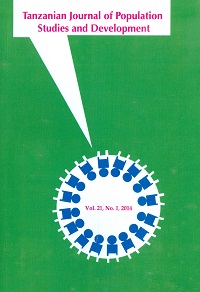Factors Affecting Contraceptive Use Among Married Women in Chuadanga District, Bangladesh
Abstract
The purpose of this study is to examine the socio-demographic determinants of contraceptive use among the married women in Chuadanga District, Bangladesh. A sample of 300 women comprising 200 from rural and 100 from urban was used. Some statistical tools such as cross tabulation, chi-square test statistic, and binary logistic regression model were used through SPSS-10, to assess the association between contraceptive use and demographic and socioeconomic variables, with special focus on contraceptive use behaviour of the married women. In our study, 88.0% of the respondents practice contraceptives, and the remaining 12.0% do not practice. Chi-square test statistics shows that respondent age at first marriage and couple ' s educational qualification are the most important significant factors that are associated with the use of contraception. The second most significant factors include current age, parity, religion and watching TV. Binary logistic regression analysis indicated that among the included socio-demographic variables only four variables €”i.e., age at first marriage, religion, both respondents ' and their spouses ' educational qualification €”are statistically significant. From the cross tabulation and logistic regression analysis, we find that women with secondary and below level are more likely to use contraceptives than higher educated women. In case of husbands ' educational level, the reverse is true. Thus, the risk of contraceptive use is higher among low level educated younger women and lower age at marriage.
References
Agresti, A. 1996. An introduction to Categorical Data Analysis. John Wiley and Sons, Inc.
Cox, D.R. 1958. The regression analysis of binary sequences. J.R. Statist. Soc. B 20:. 215 €“242.
Bongaarts, J. 1978. A framework for Analysing the Proximate Determinants of Fertility. Popul.Dev. Rev. 4, 105 €“132.
Cox, D.R. 1970. The Analysis of Binary Data. London: Methuen, Chapman and Hall
Choe, M.K. and N.O. Tsuya. 1991. Why do Chinese Women Practice contraception? The case of Rural Jilin Province. Studies in Family Planning. Vol. 22(1): 39 €“51.
Fox, J. D. 1984. Linear Statistical Models and Related Methods. New York: Wiley.
Huq, M.N., & J. Cleland. 1990. Bangladesh Fertility Survey. 1989, (Main Report), (Dhaka, National Institute of Population Research and Training).
Islam, M., T.K. Thomas, K. Barkat, M.M. Reza, & M.B. Hossain. 1998. Determinants of Contraceptive Use among Married Teenage Women and Newlywed Couples. ICDDR, B. Mahakhali, Dhaka 1212, Bangladesh, Working Paper No. 117.
Kabir, A., Q.I.U. Ibrhim, & L.A. Kawsar. 2006. Relationships Between Factors Affecting Contraception and Fertiltiy in Bangladesh. International Quarterly of Community Health Education, Vol. 24(1)/2005 €“2006, 45 €“53.
Kamal, N., & A. Slogett. 1996. The Effect of Family Planning Workers on the use of Modern Contraception in Bangladesh. Asia Pacific Population Journal, Vol.11 (3).
Laskar, M.S., M.H. Mahbub, K. Yokoyama, M. Inoue, & N. Harada. 2006. Factors associated with Contraceptive Practices of Married Women in Bangladesh with Respect to Their Employment Status. The European Journal of Contraception & Reproductive Health Care, Vol. 11(3), 220 €“227.
Lee, E.T. 1980. Statistical Methods for Survival Data Analysis. Life-time Learning Publications, Belmont, CA.
Park, K. 1997. Park ' s Text Book of Preventive and Social Medicine. Chapter- 8 Fifteenth Edition, 1167, Prem Nagar, Jabalpur, 482 001 (India).
Mitra, S.N. and Associates. 1997: Bangladesh Demographic and Health Survey, 1996 €“1997. National Institute of Population Research and Training (NIPORT), Dhaka, Bangladesh.
€”. 2001. Bangladesh Demographic and Health Survey, 1999 €“2000. National Institute of Population Research and Training (NIPORT), Dhaka, Bangladesh.
€”. 2004. Bangladesh Demographic and Health Survey, 2002 €“2003. National Institute of Population Research and Training (NIPORT), Dhaka, Bangladesh.
Mitra S.N., M.N. Ali, S. Islam, A.R. Cross, & T. Saha. 1994. Bangladesh Demographic and Health Survey, 1993 €“94. Dhaka: National Institute of Population Research and Training (NIPORT), Mitra and Associates; Calverton, MD: Macro International, Inc., 1994.
Ullah, S.M., & C. Nitai. 1993. Factors Affecting the use of Contraception in Bangladesh: A Multivariate Analysis. Asia-Pacific Population Journal, Vol. 18(3): 19 €“30.
Rahman, M.M. 2005. Socio-economic Differentials of Female Age at First Marriage: A Study of Chuadanga District, Bangladesh, Statistical Research and Training Center. J. Statist. Res. Iran 2 (2005): 69 €“92.
Samosir,B.O, M.S. Perwira, Nargis, & T.P. Widodo. 2005. Patterns of, Differentials of and Factors Influencing Male Participation in Family Planning in Indonesia. Journal of Population, Indonesia, Vol. 11(1).
U.S. Census Bureau. 2005. Population Summary for Bangladesh, IDB Summary Demographic Data for Bangladesh.
Walker, S.H., & D.B. Duncan. 1967. Estimation of the probability of an event as a function of several independent variables. Biometrika, 54: 167-179.
WHO. 1971. Technical Report, Series, No. 476.


